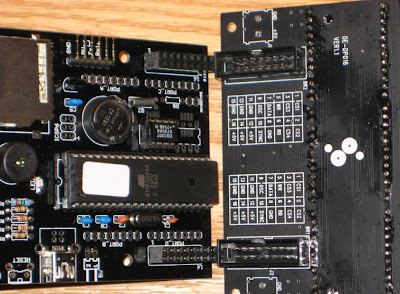Updated Feb 18/2010
The latest version of the "Wise Clock 2" code library can be downloaded here. This was tested and confirmed working in Arduino 17 (on Windows) with the sanguino libraries.
The library includes functions/classes from the following:
- DS1307;
- a modified version of the SDuFAT library;
- font3.h, the definition of the character set;
- Tone library;
- HT1632 library (for the Sure Electronics LED display), written by westfw. (HT1632 functions are included directly in Wise4Sure.pde sketch.)
Note: If you already have DS1307.zip installed, you may get an error saying that DS1307 is defined in multiple places (it is already included in WiseClock2.zip). If that is the case, delete the DS1307 folder from hardware/libraries.
Now bring on your 16x24 LED display from Sure Electronics to see Wise Clock 2 in action.
Plug the display into the Duino644 board (or vice versa :). Make sure that the display has the CS1 in the "ON" position and the other three switches are set to "OFF".

Note: The LED display board has a pair of 2-pin screw terminals on the back (face opposite to LED matrices). They may impede the Dunio644 to plug into the display board. Even if that is not the case (it did not happen to me so far), it is a good idea to extract those screw terminals, which can be useful somewhere else. The picture above shows the LED display board with the screw terminals removed.
Next, copy the two text files, time.txt and quotes.txt onto the SD card, after you made sure the card is formatted as FAT16. For information on how to check the formatting, follow this article on adafruit website.
Open the file time.txt in a text editor and modify the line containing the time. This will be the time used for setting the RTC, and it happens when the clock is powered with the time.txt file on the SD card. (After the time was set, the file is "deleted". See more information here.)
Now, after uploading the sketch to Duino644 board, the text from the file quotes.txt should be scrolling on the top half of the display, and the time should be displayed on the bottom half, as shown in this video.
Congratulations! It is now the time (pun intended :) to design a nice enclosure and to show it off to friends and family.
Related posts:













